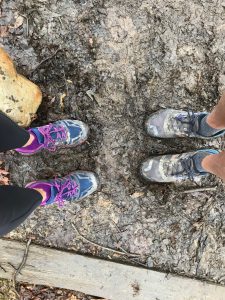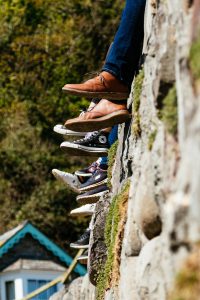This question was posted in one of my Facebook groups. I thought it was a critical question and worth sharing in a blog post. Our private Facebook group is such a fun and supportive group of women. Why don’t you join us? I answer questions posted in the group, we have challenges and talk about relevant topics, and this was one that I thought was worth diving into it.
So, what is the best sneaker for different kinds of exercise?
When I started 30 years ago as a trainer, the one shoe we had was a cross trainer, or what we called a gym shoe. The gym shoe was an all-around shoe that could be worn for weight training, aerobic classes, running, and just walking around in the streets. But there weren’t many different options as far as the type of shoe. Over the years, the fitness industry has become a big market, and shoemakers have realized that it’s time to make sport-specific shoes. But why is it important to choose different shoes for each activity?

Picture a running shoe. (Yes, the picture on the left is our running shoes AFTER a trail run) A running shoe is flexible, front and back, as you’re running or walking through the forward motion. It is cushioned on certain parts, and on other parts, it is more stable.
Now picture a tennis shoe. A tennis shoe is geared towards lateral movement, quick forward and backward movement, and needs quite a different structure to keep the foot supported but also responsive.
Those are significant differences between the shoes. Each activity that you do needs its own sneaker. Now I know, shoes can get expensive, and you may think, “Maybe I can get away with wearing the same shoe for all these things, and I’ll be fine.”
Years ago, during my marathon training, my husband noticed my “fancy shoes.” He’d often exclaim, “Whoa, are you running for hours?” Not a runner himself and a casual golfer, he found my sports passion intriguing. So, he decided to join me for a run.
He proudly presented his “athletic shoes” for our run. To his mind, they were perfect: clean and functional. However, they were actually Keds—white, flat, and not designed for sports. Although somewhat clean, they were clearly worn out.
He attempted one run in those Keds before realizing the need for proper running shoes. This experience taught us a valuable lesson: Invest in good shoes. It’s crucial to choose the right pair for your specific activity.
Your Shoe Has To Fit Properly
Then, it is important to make sure the shoe fits correctly. People often think one brand is the “best” shoe, but the “best” shoe depends on the foot. A Nike shoe could fit one person but be terrible for another.

My secret is to go to a reputable shoe fitter at a sports-specific store. For example, I buy my running shoes at a running store, and my tennis-playing friends go to a tennis store for their shoes.
If you’re doing lots of cardio, you should have the person fitting your shoes check how you walk (your gate), whether you swing a foot or a leg, or if you turn your foot in or out when you move. An excellent store will put you through a walking test first, then ask what you plan on doing with the shoe and how often you wear them. Then, finally, you will try on different shoes based on what you think is best.
Do not buy the first pair of shoes you try on just because you don’t want to try on more and don’t buy them based on what they look like. Ideally, you would like them to fit and be fashionable, but it’s better to have a pair of shoes that fit correctly versus one that goes well with your sports clothes.
When you’re trying on your shoes make sure that it’s comfortable. You shouldn’t need to spend hours and hours breaking in a shoe, tending to blisters, or whatever other problem. If you experience these problems, then take the shoe back.
It may take a couple of trips to the store to find the right shoe, so don’t get discouraged. You want to get the right shoe. So remember, they need to measure your foot, they need to evaluate your gate, and they need a little bit of an exercise history.
What’s The Best Sneaker For Different Kinds Of Exercises?

One of the things that I hear, too, is that people don’t know when their shoes are worn out or when to trade them in. I have seen friends of mine who’ve shown me their sneakers and say, “Look my shoes are great. It’s not dirty; it’s in great condition.” And then I look at the bottom of the shoe, and it’s worn away. If you have uneven wear and tear on the bottom of the shoe or the outside of the sneaker, that means it’s time to get new shoes. Your shoes could also be worn down if you start to get foot pain. Your sneakers may look okay, but you notice that your feet (or hips or knees) ache after a run. This could be a sign that it’s time for a new pair (especially if you’re putting miles and miles on your shoe).
When you notice uneven wear on your shoes, it’s time for a new pair. The clearest sign is the sole’s condition. Imagine a car tire’s profile. If your shoe sole wears thin, with a smooth, shiny surface, it’s time to retire them.
I’ve learned from my running experience that foot pain often signals worn-out shoes. A useful tip: press your hand inside the shoe. Check if the shoe bed feels flattened or worn down.
Generally, a running shoe’s lifespan is around 250 miles. The durability of sneakers depends on your mileage. While walking shoes might last a year, I go through three pairs yearly due to my running frequency.
If you want to keep track of how long your shoes last, try doing the next three things:
- Keep a log of how many miles you run or walk
- Check the inside fit and outside condition after 3 months for wear and tear
- Alternate your shoes: have two pairs of (potentially identical) shoes that you switch out every time you use them. This will reduce wear and tear on each pair and help your body stay in better condition
I hope you found this information helpful, and please feel free to ask me any questions you may have in the comments section.
You have the right sneakers and need the exercise to match them. Check out our program at HEYlifetraining.
Pingback: You got Chicked! Savageman 70.0 Triathlon